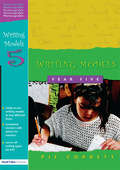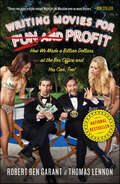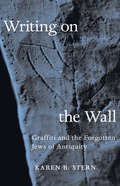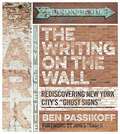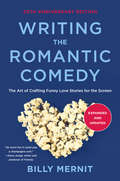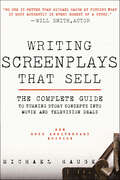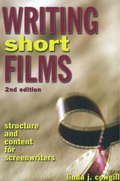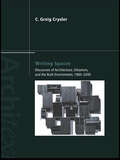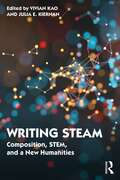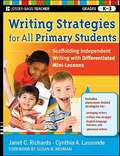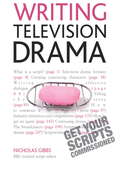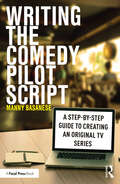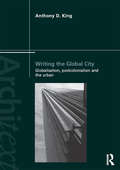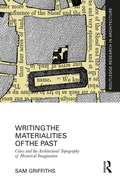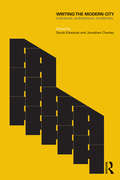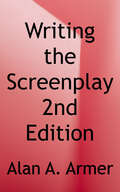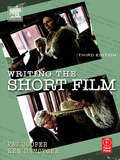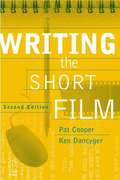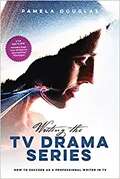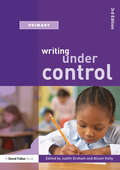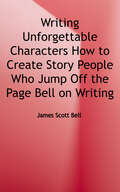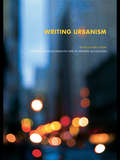- Table View
- List View
Writing Models Year 5 (Writing Models Ser.)
by Pie CorbettTeachers who want to cut planning time and save energy should welcome this series. It will help teachers to: cover every sort of writing type they need to at Key Stage with a model provided for each one; fine tune lessons by following key teaching points for each model; deliver the literacy hour to pupils of every ability using different versions of the same model.
Writing Movies for Fun and Profit: How We Made a Billion Dollars at the Box Office and You Can, Too!
by Robert Ben Garant Thomas LennonThis isthe only screenwriting guide by two guys who have actually done it (instead of some schmuck who just gives lectures about screenwriting at the airport Marriott); “These guys are proof that with no training and little education, ANYONE can make it as a screenwriter” (Paul Rudd).Robert Ben Garant and Thomas Lennon’s movies have made over a billion dollars at the box office—and now they show you how to do it yourself! This book is full of secret insider information about how to conquer the Hollywood studio system: how to write, pitch, structure, and get drunk with the best of them. Well…maybe not the best of them, but certainly the most successful. (If you’re aiming to win an Oscar, this is not the book for you!) But if you can type a little, and can read and speak English—then you too can start turning your words into stacks of money!This is the only screenwriting book you will ever need (because all other ones pretty much suck). In these pages, Garant and Lennon provide the kind of priceless tips you won’t find anywhere else, including:-The art of pitching -Getting your foot in the door -Taking notes from movie stars -How to get fired and rehired -How to get credit and royalties!And most important: what to buy with the huge piles of money you’re going to make!Writing Movies for Fun and Profit will take you through the highs and lows of life as a professional screenwriter. From the highs of hugging Gisele Bündchen and getting kung fu punched by Jackie Chan to the soul-crushing lows of Herbie: Fully Loaded.Read this book and you’ll have everything you need to make your first billion the old-fashioned way—by “selling out” in show business!A portion of the authors’ proceeds from this book are being contributed to the USO of Metropolitan Washington, a private, nonprofit organization dedicated to serving active duty military members and their families in the greater Washington, DC, region.
Writing on the Wall: Graffiti and the Forgotten Jews of Antiquity
by Karen SternFew direct clues exist to the everyday lives and beliefs of ordinary Jews in antiquity. Prevailing perspectives on ancient Jewish life have been shaped largely by the voices of intellectual and social elites, preserved in the writings of Philo and Josephus and the rabbinic texts of the Mishnah and Talmud. Commissioned art, architecture, and formal inscriptions displayed on tombs and synagogues equally reflect the sensibilities of their influential patrons. The perspectives and sentiments of nonelite Jews, by contrast, have mostly disappeared from the historical record. Focusing on these forgotten Jews of antiquity, Writing on the Wall takes an unprecedented look at the vernacular inscriptions and drawings they left behind and sheds new light on the richness of their quotidian lives.Just like their neighbors throughout the eastern and southern Mediterranean, Mesopotamia, Arabia, and Egypt, ancient Jews scribbled and drew graffiti everyplace--in and around markets, hippodromes, theaters, pagan temples, open cliffs, sanctuaries, and even inside burial caves and synagogues. Karen Stern reveals what these markings tell us about the men and women who made them, people whose lives, beliefs, and behaviors eluded commemoration in grand literary and architectural works. Making compelling analogies with modern graffiti practices, she documents the overlooked connections between Jews and their neighbors, showing how popular Jewish practices of prayer, mortuary commemoration, commerce, and civic engagement regularly crossed ethnic and religious boundaries.Illustrated throughout with examples of ancient graffiti, Writing on the Wall provides a tantalizingly intimate glimpse into the cultural worlds of forgotten populations living at the crossroads of Judaism, Christianity, paganism, and earliest Islam.
The Writing on the Wall: Rediscovering New York City's "Ghost Signs"
by James Trager Ben PassikoffThe New York Times' pick in "A Holiday Gift Guide for Hardcover Fans"A Publishers Weekly pick in "Holiday Gift Guide 2017: Illustrated Gift Books"A Photographic and Historical Record of the City’s Vanishing Advertisements As the great city of New York moves, changes, and evolves every day, the few remnants of its past go unnoticed. New York City’s "ghost signs” -advertisements painted across the facades of buildings that date back to the 19th century-are often invisible to the busy New Yorker, but defiantly conspicuous if only we turn our eyes and look upwards. These faded representations of the city’s rich economic and social history are slowly disappearing before our eyes, but not before they were captured by this photographer’s lens.At the tender age of sixteen, Ben Passikoff roamed around Manhattan with his camera to document these fascinating signs-hand-painted messages written all over the city. This photographic collection features signs painted in the 1800s as well as in the 21st century; signs that advertise funeral homes, meat, and underwear; signs stretched across iconic buildings; and even signs that are no longer legible. Using his photographs as a looking-glass into the past, Passikoff provides insightful commentary on the economic, social, and historical significance of commerce in New York City, and its vanishing ghost signs, now preserved in this photographic record.
Writing The Romantic Comedy, 20th Anniversary Expanded and Updated Edition: The Art of Crafting Funny Love Stories for the Screen
by Billy Mernit“Writing the Romantic Comedy is so much fun to read it could pop a champagne cork.”—Alexa Junge, writer and producer of FriendsRevised and expanded to celebrate a new generation of romantic comedies, Billy Mernit’s insightful look into the mechanics of writing Hollywood’s most enduring genre features case studies that reveal the screenwriting secrets behind classics new and old.Whether you’re a first-time screenwriter, an intermediate marooned in the rewriting process, or a professional wanting to explore the latest genre trends, this thoroughly charming and insightful guide to the basics of crafting a winning and innovative script will take you step by step from “meet cute” all the way to “joyous defeat.” You’ll learn the screenwriting secrets behind some of the funniest scenes ever written; how to create characters and dialogue that getsparks flying; why some bedroom scenes sizzle and others fall flat; and much more. Written in a refreshingly accessible style and updated and expanded to recognize the contributions of a fresh generation of romantic comedies, this newly revised 20th Anniversary edition of Writing the Romantic Comedy features case studies drawn from beloved romantic classics such as When Harry Met Sally, Annie Hall, Tootsie, and The Lady Eve to modern-day favorites including Hitch, (500) Days of Summer, Bridesmaids, and Silver Linings Playbook. Field-tested writing exercises are also included, guaranteed to short-circuit potential mistakes and ensure inspiration.
Writing Screenplays That Sell: The Complete Guide to Turning Story Concepts into Movie and Television Deals
by Michael HaugeFor more than twenty years, Writing Screenplays That Sell has been hailed as the most complete guide available on the art, craft, and business of writing for movies and television. Now fully revised and updated to reflect the latest trends and scripts, Hollywood story expert and script consultant Michael Hauge walks readers through every step of writing and selling successful screenplays. If you read only one book on the screenwriter's craft, this must be the one.
Writing Short Films: Structure and Content for Screenwriters
by Linda J. CowgillThis new edition has been completely updated and revised along with the addition of several new chapters. Currently, this title remains the best selling university text book on writing short film screenplays.
Writing Spaces: Discourses of Architecture, Urbanism and the Built Environment, 1960–2000 (Architext)
by C. Greig CryslerWriting Spaces examines some of the most important discourses in spatial theory of the last four decades, and considers their impact within the built environment disciplines. The book will be a key resource for courses on critical theory in architecture, urban studies and geography, at both the graduate and advanced undergraduate level.
Writing STEAM: Composition, STEM, and a New Humanities
by Vivian KaoThis edited collection positions writing at the center of interdisciplinary higher education, and explores how writing instruction, writing scholarship, and writing program administration bring STEM and the humanities together in meaningful, creative, and beneficial ways. Writing professionals are at the forefront of a cross-pollination between STEM (Science, Technology, Engineering, and Mathematics) and the arts and humanities. In their work as educators, scholars, and administrators, they collaborate with colleagues in engineering, scientific, technical, and health disciplines, offer new degree programs that allow students to bring the humanities to bear on design experiments, and build an academic culture that promotes a vision of the humanities in the twenty-first century, as well as a vision of technology that is decidedly human. This collection surveys and promotes that work through chapters focused on writing instruction, writing scholarship, and writing program administration, covering topics that include data-driven writing courses, public science communication, non-traditional college students, creative writing, gamification, skills transfer, and Writing Across the Curriculum programs. Writing STEAM will be essential reading for scholars, instructors, and administrators in writing studies, rhetoric and composition, STEM, and a variety of interdisciplinary programs; it will aid in teacher training for both humanities and STEM courses focused on writing and communication.
Writing STEAM: Composition, STEM, and a New Humanities
by Vivian KaoThis edited collection positions writing at the center of interdisciplinary higher education, and explores how writing instruction, writing scholarship, and writing program administration bring STEM and the humanities together in meaningful, creative, and beneficial ways.Writing professionals are at the forefront of a cross-pollination between STEM (Science, Technology, Engineering, and Mathematics) and the arts and humanities. In their work as educators, scholars, and administrators, they collaborate with colleagues in engineering, scientific, technical, and health disciplines, offer new degree programs that allow students to bring the humanities to bear on design experiments, and build an academic culture that promotes a vision of the humanities in the twenty-first century, as well as a vision of technology that is decidedly human. This collection surveys and promotes that work through chapters focused on writing instruction, writing scholarship, and writing program administration, covering topics that include data-driven writing courses, public science communication, non-traditional college students, creative writing, gamification, skills transfer, and Writing Across the Curriculum programs. Writing STEAM will be essential reading for scholars, instructors, and administrators in writing studies, rhetoric and composition, STEM, and a variety of interdisciplinary programs; it will aid in teacher training for both humanities and STEM courses focused on writing and communication.
Writing Strategies for All Primary Students
by Janet C. Richards Cynthia A. LassondeA guide for teaching all your students the skills they need to be successful writersThe 25 mini-lessons provided in this book are designed to develop students' self-regulated writing behaviors and enhance their self-perceived writing abilities. These foundational writing strategies are applicable and adaptable to all primary students: emergent, advanced, English Language Learners, and struggling writers. Following the SCAMPER (Screen and assess, Confer, Assemble materials, Model, Practice, Execute, Reflect) mini-lesson model devised by the authors, the activities show teachers how to scaffold the writing strategies that students need in order to take control of their independent writing.Reveals helpful writing strategies, including making associations, planning, visualizing, accessing cues, using mnemonics, and moreOffers ideas for helping students revise, check, and monitor their writing assignmentsExplains the author's proven SCAMPER model that is appropriate for students in grades K-3Let Richards and Lassonde--two experts in the field of childhood education--guide you through these proven strategies for enhancing young children's writing skills.
Writing Television Drama: Teach Yourself
by Nicholas GibbsBreak Into Writing For Television takes you from the very first line of the script through to becoming a regular writer for soaps and 'continuing dramas'. It starts with the basics of different types of script and production, and moves on to getting ideas, shaping character and dialogue, re-writing, pitching work and the practicalities of who does what in the production world, in both the UK and the US. Structured around a practical, progressive, goal-orientated approach, each chapter contains a diagnostic test, case studies, practical exercises and Aide Memoire boxes. Each chapter concludes with a reminder of the key points of the chapter (Focus Points) and a round-up of what to expect in the next (Next Step), which will whet your appetite for what's coming and how it relates to what you've just read.
Writing Television Drama: Get Your Scripts Commissioned
by Nicholas GibbsBreak Into Writing For Television takes you from the very first line of the script through to becoming a regular writer for soaps and 'continuing dramas'. It starts with the basics of different types of script and production, and moves on to getting ideas, shaping character and dialogue, re-writing, pitching work and the practicalities of who does what in the production world, in both the UK and the US. Structured around a practical, progressive, goal-orientated approach, each chapter contains a diagnostic test, case studies, practical exercises and Aide Memoire boxes. Each chapter concludes with a reminder of the key points of the chapter (Focus Points) and a round-up of what to expect in the next (Next Step), which will whet your appetite for what's coming and how it relates to what you've just read.
Writing the Comedy Pilot Script: A Step-by-Step Guide to Creating an Original TV Series
by Manny BasaneseNavigating through the challenging process of writing a comedy pilot, this book will help screenwriters to create an original script for television. Practical and accessible, the book presents a step-by-step guide focusing on the key elements of the process. Incorporating both the history of TV comedy as well as its current evolving state in this age of the dramedy and an ever-increasing variety of broadcast and streaming platforms, the book will serve as a guide for the fledgling sitcom scribe. Author Manny Basanese breaks down the comedy pilot writing process from what may be perceived as an overwhelming, time-consuming mission into a series of much more manageable, smaller steps (from logline to outline to 1st, 2nd and polished draft). Utilizing his experience in Hollywood’s sitcom trenches, the author offers real-world advice on such topics as building the comedy pilot "world," creating memorable comic characters, sound sitcom structure, and the importance of crafting an emotional through line in a comedy pilot. Finally, there is also practical career guidance for marketing this just-completed script and breaking into the industry with advice on various topics such as the value of networking as well as gaining representation in the competitive Hollywood jungle. It is ideal for students of screenwriting and aspiring comedy screenwriters.
Writing the Global City: Globalisation, Postcolonialism and the Urban (Architext)
by Anthony D KingOver the last three decades, our understanding of the city worldwide has been revolutionized by three innovative theoretical concepts – globalisation, postcolonialism and a radically contested notion of modernity. The idea and even the reality of the city has been extended out of the state and nation and re-positioned in the larger global world. In this book Anthony King brings together key essays written over this period, much of it dominated by debates about the world or global city. Challenging assumptions and silences behind these debates, King provides largely ignored historical and cultural dimensions to the understanding of world city formation as well as decline. Interdisciplinary and comparative, the essays address new ways of framing contemporary themes: the imperial and colonial origin of contemporary world and global cities, actually existing postcolonialisms, claims about urban and cultural homogenisation and the role of architecture and built environment in that process. Also addressed are arguments about indigenous and exogenous perspectives, Eurocentricism, ways of framing vernacular architecture, and the global historical sociology of building types. Wide-ranging and accessible, Writing the Global City provides essential historical contexts and theoretical frameworks for understanding contemporary urban and architectural debates. Extensive bibliographies will make it essential for teaching, reference and research.
Writing the History of the British Stage, 1660–1900
by Richard SchochThis is the first book on British theatre historiography. It traces the practice of theatre history from its origins in the Restoration to its emergence as an academic discipline in the early twentieth century. In this compelling revisionist study, Richard Schoch reclaims the deep history of British theatre history, valorizing the usually overlooked scholarship undertaken by antiquarians, booksellers, bibliographers, journalists and theatrical insiders, none of whom considered themselves to be professional historians. Drawing together deep archival research, close readings of historical texts from the seventeenth, eighteenth and nineteenth centuries, and an awareness of contemporary debates about disciplinary practice, Schoch overturns received interpretations of British theatre historiography and shows that the practice - and the diverse practitioners - of theatre history were far more complicated and far more sophisticated than we had realised. His book is a landmark contribution to how theatre historians today can understand their own history.
Writing the Materialities of the Past: Cities and the Architectural Topography of Historical Imagination (Routledge Research in Architecture)
by Sam GriffithsWriting the Materialities of the Past offers a close analysis of how the materiality of the built environment has been repressed in historical thinking since the 1950s. Author Sam Griffiths argues that the social theory of cities in this period was characterised by the dominance of socio-economic and linguistic-cultural models, which served to impede our understanding of time-space relationality towards historical events and their narration. The book engages with studies of historical writing to discuss materiality in the built environment as a form of literary practice to express marginalised dimensions of social experience in a range of historical contexts. It then moves on to reflect on England’s nineteenth-century industrialization from an architectural topographical perspective, challenging theories of space and architecture to examine the complex role of industrial cities in mediating social changes in the practice of everyday life. By demonstrating how the authenticity of historical accounts rests on materially emplaced narratives, Griffiths makes the case for the emancipatory possibilities of historical writing. He calls for a re-evaluation of historical epistemology as a primarily socio-scientific or literary enquiry and instead proposes a specifically architectural time-space figuration of historical events to rethink and refresh the relationship of the urban past to its present and future. Written for postgraduate students, researchers and academics in architectural theory and urban studies, Griffiths draws on the space syntax tradition of research to explore how contingencies of movement and encounter construct the historical imagination.
Writing the Modern City: Literature, Architecture, Modernity
by Sarah Edwards Jonathan CharleyLiterary texts and buildings have always represented space, narrated cultural and political values, and functioned as sites of personal and collective identity. In the twentieth century, new forms of narrative have represented cultural modernity, political idealism and architectural innovation. Writing the Modern City explores the diverse and fascinating relationships between literature, architecture and modernity and considers how they have shaped the world today. This collection of thirteen original essays examines the ways in which literature and architecture have shaped a range of recognisably ‘modern’ identities. It focuses on the cultural connections between prose narratives – the novel, short stories, autobiography, crime and science fiction – and a range of urban environments, from the city apartment and river to the colonial house and the utopian city. It explores how the themes of memory, nation and identity have been represented in both literary and architectural works in the aftermath of early twentieth-century conflict; how the cultural movements of modernism and postmodernism have affected notions of canonicity and genre in the creation of books and buildings; and how and why literary and architectural narratives are influenced by each other’s formal properties and styles. The book breaks new ground in its exclusive focus on modern narrative and urban space. The essays examine texts and spaces that have both unsettled traditional definitions of literature and architecture and reflected and shaped modern identities: sexual, domestic, professional and national. It is essential reading for students and researchers of literature, cultural studies, cultural geography, art history and architectural history.
Writing the Screenplay: TV and Film
by Alan A. ArmerIn this new edition, Emmy - Award winner Alan Armer takes aspiring writers through the essential steps needed to create successful dramatic scripts for TV and Film: visual thinking characters and plotting, story structure and conflict, dialog, and formats.
Writing the Short Film
by Ken Dancyger Patricia CooperThe short film is a unique narrative art form that, while lending itself to experimentation, requires tremendous discipline in following traditional filmic considerations. This book takes the student and novice screenwriter through the storytelling process- from conception, to visualization, to dramatization, to characterization and dialogue- and teaches them how to create a dramatic narrative that is at once short (approximately half an hour in length) and complete. Exercises, new examples of short screenplays, and an examination of various genres round out the discussion.NEW TO THE THIRD EDITION: new screenplays, a chapter on rewriting your script, and a chapter on the future of short films
Writing the Short Film (second edition)
by Ken Dancyger Pat CooperWriters who want to write a fil will find this to be a useful book. The usefulness of this book goes beyond the writing or filmmaking class.
Writing The TV Drama Series: How To Succeed As A Professional Writer In TV
by Pamela DouglasThis revised and updated edition is a complete resource for anyone who wants to write and produce for television drama series or create an original series, as well as for teachers in screenwriting classes and workshops. It leads the reader step-by-step through every stage of the development and writing process, offering practical industry information and artistic inspiration. The Fourth Edition leads readers into the future and engages provocative issues about the interface between traditional TV and emerging technologies. It’s also the single most comprehensive source on what is happening in original television drama around the world, with surveys of 15 countries.
Writing Under Control
by Alison Kelly Judith GrahamNow in its third edition and reflecting changes in the Primary National Strategy, this best-selling textbook introduces primary teachers to key issues in the teaching of writing. Strongly rooted in classroom practice, the book includes: the history, theory and practice of teaching writing children writing in and out of school EAL and gender issues in writing the development of writing across the years of the primary school planning classroom routines and organising resources balancing the composition and transcription elements in writing monitoring and assessing writing meeting individual needs managing specific learning difficulties in writing, such as dyslexia With its companion Reading under Control (also in its third edition), this book provides undergraduate and postgraduate teachers with comprehensive guidance for the teaching of literacy.
Writing Unforgettable Characters: How to Create Story People Who Jump off the Page (Bell On Writing Ser. #Vol. 12)
by James Scott BellWhat will take your fiction from good to great? From decent to dazzling? From lackluster to blockbuster? Characters who "jump off the page." Of course plot matters. So does conflict, and scenes, and every other aspect of the fiction craft. But without unforgettable characters, your books will always be less than they could be. Don't let that happen. In this book, you'll learn: -How to lay the foundation for a memorable character -How to bond the reader with the main character from the start -The super power of unpredictability -The secrets of grit, wit, and moxie -How to bring your character to life on the page-How and when to reveal backstory -All about arcs and what they truly mean -The key to unforgettable villains-How to make minor characters memorable, too -How to create a great series character And more, PLUS the powerful exercises James Scott Bell has taught in his sold-out writing workshops. No more flat stories! Give your readers what will turn them into career-long fans-characters who jump off the page.
Writing Urbanism: A Design Reader (The ACSA Architectural Education Series)
by Douglas Kelbaugh Kit McCulloughUrban design continues to grow as an increasingly important and expanding field of study, research and professional endeavour. Distinguished by its broad scope and comprehensiveness on the subject of urban design, this new collection combines selected essays from both practitioners and academia. Writing Urbanism is the ideal volume for both students, architects and urban designers.
